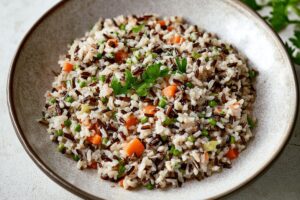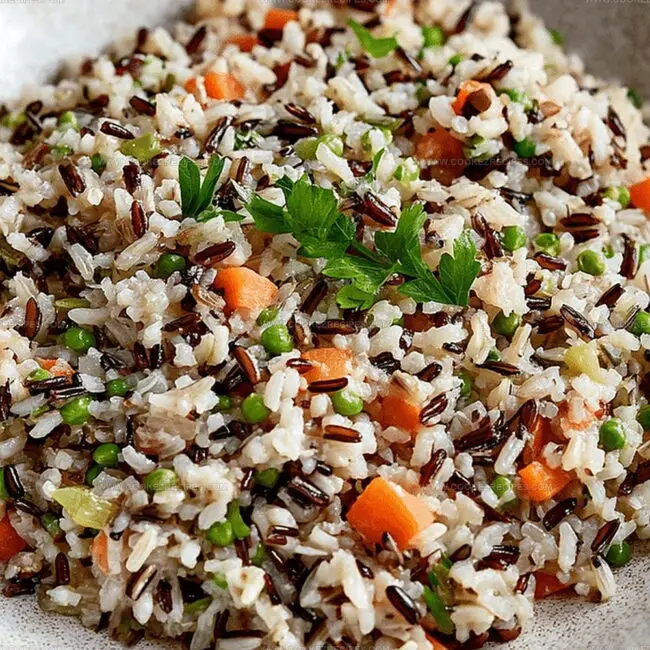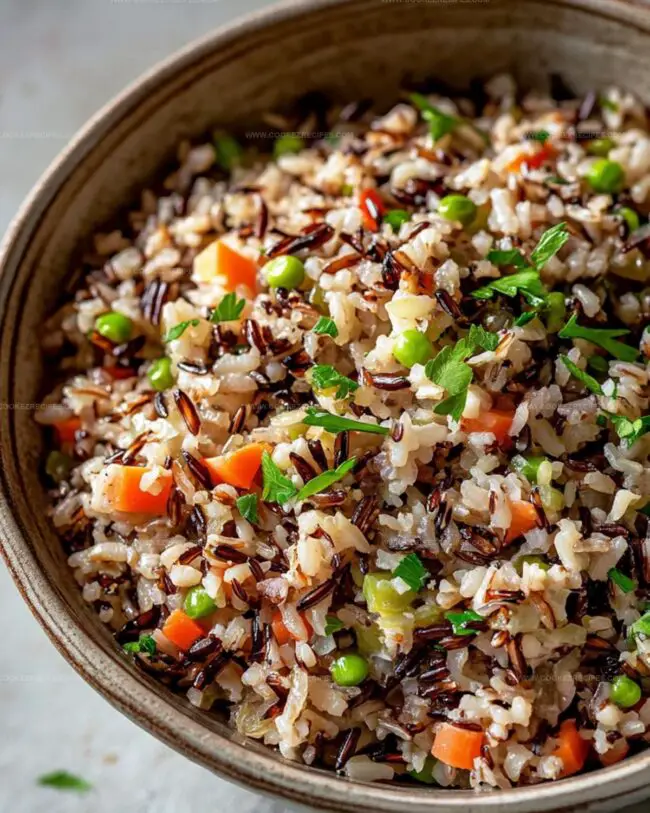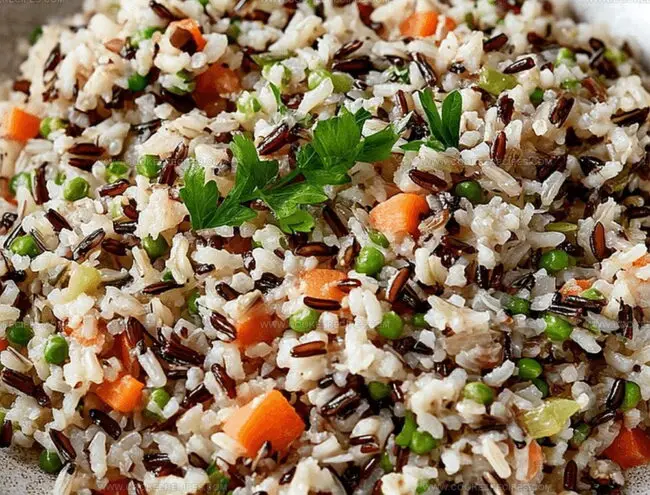Fluffy and Flavorful Homemade Wild Rice Pilaf Recipe
Wild rice whispers stories of culinary adventure on your plate, promising a journey beyond ordinary side dishes.
Nutty kernels dance with vibrant vegetables, creating a symphony of textures and flavors.
Each grain carries the essence of Minnesota’s wilderness, carefully cultivated and lovingly prepared.
Earthy undertones complement delicate seasonings that awaken your taste buds.
Mediterranean herbs mingle with robust grains, offering a sophisticated twist to a classic companion.
Nutritious and satisfying, this pilaf stands as a testament to simple ingredients transformed into something extraordinary.
Wild Rice Pilaf: Nutty, Earthy Deliciousness
Elements of Wild Rice Pilaf
Grains:Liquid Base:Vegetables:Herbs and Seasonings:Fats:Seasonings:Directions for Making Wild Rice Pilaf
Step 1: Boil Wild Rice Blend
In a saucepan, combine wild rice blend with chicken broth.
Season generously with salt and pepper.
Bring the mixture to a rolling boil, then reduce heat to medium.
Simmer uncovered, watching carefully and adding water as needed to prevent sticking or burning.
Cook until rice reaches a tender texture, typically between 30-45 minutes.
Step 2: Sauté Colorful Vegetables
Warm a large skillet with butter and oil over medium-high heat.
Add vegetables in stages:Cook each vegetable for 3-4 minutes, allowing them to develop a slight caramelization.
Introduce scallions and minced garlic, sautéing for an additional 1-2 minutes until fragrant.
Step 3: Blend Flavors and Seasonings
Sprinkle poultry seasoning and curry powder into the vegetable mixture.
If rice is still cooking, remove skillet from heat.
Once rice is fully cooked, drain thoroughly in a sieve.
Transfer rice to the skillet and mix thoroughly with vegetables.
Taste and adjust seasonings as desired.
Step 4: Garnish and Serve
Fold fresh parsley into the pilaf, creating a vibrant and aromatic finish.
Transfer to a beautiful serving dish and garnish with additional parsley for visual appeal and extra flavor.
Smart Moves With Wild Rice Pilaf
Wild Rice Pilaf Made to Taste Great Twice
Balanced Bites For Pilaf
Wild Rice Pilaf Flavor Variants
FAQs
Wild rice is actually a grass seed native to North America, not a true rice. It has a chewy texture, nutty flavor, and more protein and fiber compared to white rice.
Yes, vegetable broth works perfectly as a substitute and keeps the recipe vegetarian while maintaining similar flavor depth and moisture.
Wild rice blend typically contains a mix of different rice types, including wild rice, brown rice, and sometimes white rice. This provides varied textures and nutritional benefits compared to pure wild rice.
Consider adding cooked chicken, tofu, or roasted almonds to increase protein content. These additions complement the wild rice’s nutty flavor and enhance the dish’s nutritional profile.
Print
Wild Rice Pilaf Recipe
- Total Time: 1 hour 15 minutes
- Yield: 6 1x
Description
Hearty wild rice pilaf brings Mediterranean warmth to dinner tables with its aromatic blend of herbs and nutty grains. Rich flavors and textures invite you to explore a comforting culinary journey through simple yet elegant ingredients.
Ingredients
Main Ingredients:
- 2 1/2 cups wild rice blend, rinsed
- 4 cups chicken broth (or vegetable broth)
- 3 tablespoons butter
- 1 tablespoon canola oil
Vegetables:
- 1 stalk celery, finely chopped
- 1 large carrot, chopped
- 1/2 medium red bell pepper, finely chopped
- 1 bunch scallions, finely chopped (white and light green parts only)
- 3 cloves garlic, minced
- 1/2 cup chopped fresh parsley (plus more for garnish)
Seasonings:
- Water, as needed
- Salt and freshly ground black pepper, to taste
- 1 1/2 teaspoons poultry seasoning
- 1/2 teaspoon curry powder
Instructions
- Prepare rice foundation by gently combining wild rice blend with aromatic chicken broth, incorporating a delicate balance of salt and freshly ground black pepper.
- Allow liquid to reach a vigorous boil, then reduce temperature to a gentle simmer, permitting rice to transform and soften over 30-45 minutes.
- Monitor liquid levels periodically, supplementing with water to prevent scorching and ensure consistent moisture throughout cooking process.
- Simultaneously, activate a large skillet with a harmonious blend of butter and oil, creating a golden cooking surface.
- Introduce robust vegetables – crisp celery and vibrant carrots – sautéing until they develop slight tenderness and caramelized edges.
- Incorporate bright red bell peppers, continuing to enhance vegetable medley with gentle movement and consistent heat.
- Elevate flavor profile by adding delicate scallions and fragrant garlic, allowing aromatics to release their essence.
- Sprinkle poultry seasoning and exotic curry powder, infusing the vegetable mixture with complex, layered notes.
- Carefully drain cooked rice through a fine-meshed sieve, eliminating excess moisture.
- Merge rice with vegetable mixture, creating a harmonious culinary composition.
- Assess and refine seasoning, adjusting salt and pepper to personal preference.
- Finish dish with fresh, verdant parsley, adding brightness and visual appeal.
- Transfer to elegant serving vessel, garnishing with additional herbaceous parsley sprigs.
Notes
- Customize the rice blend by mixing different varieties like brown, wild, and white rice for a unique texture and flavor profile.
- Choose low-sodium chicken broth to control salt intake and allow more seasoning flexibility during cooking.
- Toast rice briefly before adding liquid to enhance nutty undertones and improve overall depth of taste.
- Substitute butter with olive oil for a lighter, heart-healthy version that works perfectly for vegetarian and vegan diets.
- Prep Time: 30 minutes
- Cook Time: 45 minutes
- Category: Lunch, Dinner
- Method: Simmering
- Cuisine: American
Nutrition
- Serving Size: 6
- Calories: 290
- Sugar: 2 g
- Sodium: 400 mg
- Fat: 12 g
- Saturated Fat: 5 g
- Unsaturated Fat: 6 g
- Trans Fat: 0 g
- Carbohydrates: 39 g
- Fiber: 4 g
- Protein: 7 g
- Cholesterol: 15 mg





Daniel Bruns
Founder & Culinary Innovator
Expertise
Recipe development for home cooks, Nutritional analysis and meal planning, Culinary education and food writing
Education
Auguste Escoffier School of Culinary Arts
Diploma in Culinary Arts and Operations
Focus: Classical and contemporary cooking techniques, Culinary entrepreneurship and kitchen management, Menu development and food cost analysis
Daniel’s story started with flour on his face and a pie in the oven at his grandma’s house. He later sharpened his skills at the Auguste Escoffier School of Culinary Arts.
His goal? Recipes so simple you’ll want to cook every night. When he’s not whipping up one-pan wonders, Daniel’s outside picking herbs, hosting neighborhood cook-offs, or baking chocolate cakes with his kids, messy, sweet, and unforgettable.